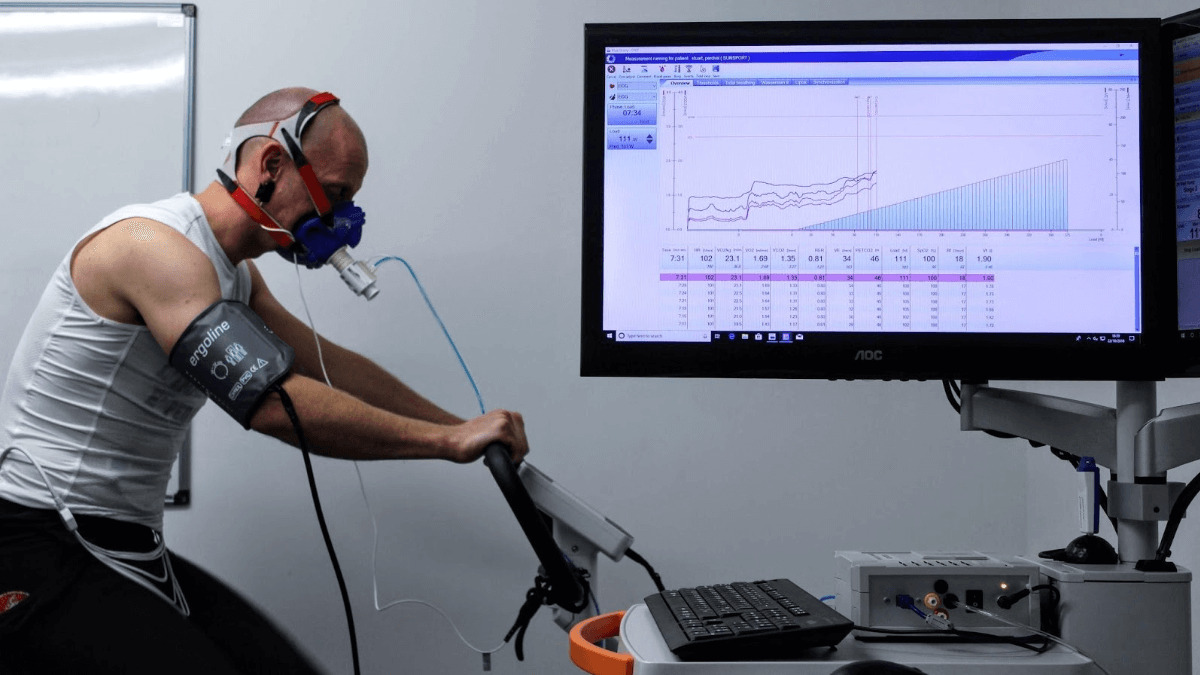

Featured
How Important Is Cardiovascular Fitness
Modified: August 21, 2023
Improve your cardiovascular fitness with our featured workouts and tips. Enhance your overall health and well-being with effective cardio exercises.
Introduction
Welcome to the world of cardiovascular fitness, where the health and vitality of your heart and lungs take center stage. Cardiovascular fitness, also known as cardiorespiratory fitness, refers to the ability of your heart, lungs, and blood vessels to effectively supply oxygen-rich blood to your muscles during physical activity. It is a vital component of overall fitness and plays a crucial role in maintaining good health.
Cardiovascular fitness is not just about endurance; it impacts every aspect of your well-being. Whether you want to improve your athletic performance, manage your weight, reduce your risk of chronic diseases, or simply feel more energized, focusing on your cardiovascular fitness is key.
The benefits of cardiovascular fitness are numerous and far-reaching. Regular aerobic exercise, which is the cornerstone of cardiovascular fitness training, has been shown to improve heart health, boost stamina, increase lung capacity, enhance mood, and reduce the risk of various health conditions such as cardiovascular disease, diabetes, and even certain types of cancer.
But what exactly does cardiovascular fitness entail? In simple terms, it refers to the strength and efficiency of your cardiovascular system. When you engage in activities that elevate your heart rate and make you breathe harder, your heart works harder, pumping more oxygenated blood to your muscles. Over time, with regular exercise, your heart becomes stronger and more efficient, allowing it to pump more blood with less effort. This efficiency not only improves your performance during workouts but also benefits you during everyday tasks, helping you feel less fatigued and more energized.
Now, you might be wondering how cardiovascular fitness ties into weight management. Well, the answer lies in the fact that aerobic exercise, the type of exercise that improves cardiovascular fitness, burns calories. When you engage in activities like running, swimming, or cycling, you not only challenge your cardiovascular system but also burn calories, helping you maintain a healthy weight or even lose excess pounds.
So, have you been neglecting your cardiovascular fitness? Don’t worry, you’re not alone. Many people focus primarily on strength training or other forms of exercise, often overlooking the importance of cardiovascular fitness. But fear not, because improving your cardiovascular fitness is not as daunting as it may seem. With the right knowledge and a little dedication, you can start enhancing your cardiovascular fitness and reaping the rewards it offers.
In this article, we will explore different aspects of cardiovascular fitness, including the benefits, the impact on overall health, ways to improve, and the best aerobic exercises to boost cardiovascular fitness. So, are you ready to take your cardiovascular fitness to the next level? Let’s dive in!
Understanding Cardiovascular Fitness
Before we delve deeper into the world of cardiovascular fitness, it’s essential to understand what it entails. Cardiovascular fitness is a measure of the efficiency of your heart, lungs, and blood vessels in delivering oxygen to your muscles during physical activity. It involves the ability of your cardiovascular system to supply oxygen-rich blood to working muscles and remove waste products like carbon dioxide.
The primary organ of focus is the heart, a powerful muscle responsible for pumping blood throughout your body. As you engage in aerobic activities, such as walking, running, or cycling, your heart rate increases, pumping more blood and oxygen to your muscles. This increased blood flow helps to nourish your muscles and provides them with the fuel needed to sustain the activity.
Your lungs also play a crucial role in cardiovascular fitness by supplying oxygen to the blood and removing carbon dioxide, a waste product produced by your muscles. Deep and steady breathing is essential during aerobic exercise to ensure an adequate supply of oxygen to the body.
Another essential component of cardiovascular fitness is your blood vessels. Arteries and veins carry blood throughout your body, delivering oxygen and nutrients to the tissues and removing waste products. Regular aerobic exercise helps to keep your blood vessels healthy, maintaining their elasticity and promoting efficient blood flow.
Understanding cardiovascular fitness goes beyond knowing its components; it also involves recognizing the various factors that can affect it. Age, genetics, lifestyle habits, and underlying health conditions can all influence your cardiovascular fitness levels.
Age plays a role in cardiovascular fitness as our bodies naturally go through changes over time. As we age, our hearts may not pump as efficiently as they used to, and our lung capacity may decrease. However, regular exercise can help slow down these age-related declines and maintain optimal cardiovascular fitness.
Genetics also play a role in determining our cardiovascular fitness potential. Some individuals may be naturally predisposed to higher levels of cardiovascular fitness, while others may have to work harder to achieve the same level of fitness. It’s important to remember that regardless of your genetic makeup, everyone can improve their cardiovascular fitness with the right exercise regimen.
Lifestyle habits, such as smoking, sedentary behavior, and a poor diet, can negatively impact cardiovascular fitness. These habits can lead to the buildup of plaque in the arteries, reducing blood flow and increasing the risk of heart disease. Making positive changes to your lifestyle, such as quitting smoking, incorporating regular exercise, and eating a balanced diet, can greatly improve your cardiovascular fitness.
Underlying health conditions, such as hypertension, high cholesterol, and diabetes, can also affect cardiovascular fitness. It is important to work with your healthcare provider to manage these conditions and ensure that your exercise routine is safe and effective.
By understanding the components of cardiovascular fitness and the factors that can influence it, you can take the necessary steps to improve and maintain optimal cardiovascular fitness levels. In the following sections, we will explore the benefits of cardiovascular fitness, the impact on overall health, and how to improve your cardiovascular fitness through various exercises and techniques.
The Benefits of Cardiovascular Fitness
Engaging in regular cardiovascular fitness exercises offers a wide range of benefits that go beyond just improving your endurance. Let’s take a closer look at some of the advantages of having good cardiovascular fitness:
- Improved heart health: One of the most significant benefits of cardiovascular fitness is its positive impact on heart health. Regular aerobic exercise strengthens the heart muscle, making it more efficient in pumping blood throughout the body. This can help reduce the risk of heart disease, lower blood pressure, and improve overall cardiovascular function.
- Increased stamina and endurance: Cardiovascular fitness enhances your stamina and endurance levels, allowing you to engage in prolonged activities without feeling fatigued. Whether it’s participating in a long-distance run or keeping up with the demands of daily life, having good cardiovascular fitness boosts your energy levels and enhances your performance.
- Enhanced lung capacity: Aerobic exercises that improve cardiovascular fitness also strengthen the muscles involved in breathing, such as the diaphragm and intercostal muscles. This leads to an increase in lung capacity, allowing for more efficient oxygen intake and carbon dioxide elimination. As a result, you may experience improved respiratory function and better overall lung health.
- Weight management: Including cardiovascular exercises in your fitness routine can be an effective tool for managing your weight. Aerobic activities such as running, cycling, or swimming help burn calories, contributing to weight loss or weight maintenance. Regular cardiovascular exercise can also help increase your metabolic rate, making it easier to manage your weight in the long term.
- Mood enhancement: Cardiovascular exercise has been shown to have a positive impact on mood and mental well-being. It stimulates the release of endorphins, also known as “feel-good” hormones, which can help reduce anxiety, alleviate stress, and improve overall mood. Engaging in cardiovascular fitness activities can provide a natural boost to your mental and emotional state.
- Reduced risk of chronic diseases: Regular cardiovascular exercise has been linked to a decreased risk of chronic diseases such as cardiovascular disease, diabetes, and certain types of cancer. This is because cardiovascular fitness helps to improve blood circulation, reduce inflammation, control blood sugar levels, and improve immune function, all of which contribute to a lower risk of developing these conditions.
The benefits of cardiovascular fitness extend beyond physical health and extend to various aspects of your well-being. By incorporating cardiovascular exercises into your routine, you can enjoy improved heart health, increased stamina, better lung capacity, weight management, enhanced mood, and a reduced risk of chronic diseases.
Now that we’ve explored the benefits of cardiovascular fitness, let’s dive deeper into the impact of cardiovascular fitness on overall health and wellness in the next section.
The Impact of Cardiovascular Fitness on Overall Health
Cardiovascular fitness has a significant impact on your overall health and well-being. Let’s delve into the various ways that cardiovascular fitness can positively influence your health:
- Reduced risk of cardiovascular disease: Engaging in regular cardiovascular exercise has been shown to significantly reduce the risk of developing cardiovascular diseases such as heart disease, stroke, and high blood pressure. By strengthening your heart muscle and improving blood flow, cardiovascular fitness helps to keep your cardiovascular system healthy and functioning optimally.
- Improved blood pressure control: High blood pressure, or hypertension, is a common health issue that can lead to serious complications. Regular cardiovascular exercise has been proven to help lower blood pressure by improving blood vessel function, reducing arterial stiffness, and enhancing the overall elasticity of blood vessels. This can help prevent hypertension and reduce the risk of related complications.
- Enhanced metabolic health: Cardiovascular fitness plays a crucial role in maintaining a healthy metabolism. Regular aerobic exercise helps to increase insulin sensitivity, allowing your cells to use glucose more efficiently and reducing the risk of insulin resistance and type 2 diabetes. It also promotes the breakdown of fats and the utilization of stored energy, contributing to weight management and improving overall metabolic health.
- Stronger immune system: Cardiovascular fitness has been linked to a strengthened immune system. Regular exercise promotes the circulation of immune cells throughout the body, making them more efficient at detecting and fighting off potential pathogens. This can help reduce the risk of infections and enhance your body’s ability to recover from illness.
- Improved cognitive function: Cardiovascular fitness has a positive impact on brain health and cognitive function. Regular aerobic exercise increases blood flow to the brain, delivering oxygen and nutrients necessary for optimal brain function. It also stimulates the release of neurotransmitters and growth factors, promoting neurogenesis and enhancing cognitive abilities such as memory, attention, and problem-solving.
- Reduced risk of mental health disorders: Research has shown that cardiovascular fitness is associated with a lower risk of mental health disorders such as depression and anxiety. Regular exercise triggers the release of endorphins, serotonin, and dopamine, which are neurotransmitters that improve mood and reduce stress. Engaging in cardiovascular fitness activities can provide a natural and effective way to support mental and emotional well-being.
The impact of cardiovascular fitness on overall health is multifaceted, extending beyond physical well-being to encompass cardiovascular health, blood pressure control, metabolic health, immune function, cognitive function, and mental health. By prioritizing cardiovascular fitness and incorporating regular aerobic exercise into your routine, you can enhance your overall health and well-being.
Next, let’s explore the relationship between cardiovascular fitness and weight management in the following section.
Cardiovascular Fitness and Its Role in Weight Management
When it comes to weight management, cardiovascular fitness plays a crucial role. Regular aerobic exercise, which is essential for cardiovascular fitness, can be an effective tool for achieving and maintaining a healthy weight. Let’s explore how cardiovascular fitness contributes to weight management:
Calorie burning: Engaging in aerobic activities such as running, cycling, or swimming can help you burn a significant number of calories. These activities require continuous movement and exertion, resulting in a higher energy expenditure compared to other forms of exercise. By consistently engaging in cardiovascular exercise, you can create a calorie deficit, which is essential for weight loss. The more intense your cardio workouts and the longer the duration, the more calories you will burn.
Increase in metabolic rate: Cardiovascular fitness can also have a positive impact on your metabolic rate. Regular aerobic exercise has been shown to increase resting metabolic rate, which is the number of calories your body burns at rest. This means that even when you’re not actively exercising, your body will be burning more calories compared to someone with a lower metabolic rate. This can aid in weight management by helping you burn more calories throughout the day.
Preservation of lean muscle mass: When you engage in an exercise routine focused on cardiovascular fitness, you can help preserve and even build lean muscle mass. While aerobic exercise primarily targets the cardiovascular system, it still engages various muscle groups in your body. This can help improve muscle tone and increase your overall muscle mass. Having more lean muscle mass is beneficial for weight management as muscle burns more calories at rest compared to fat. So, the more lean muscle mass you have, the higher your resting metabolic rate will be.
Combination with strength training: Incorporating cardiovascular exercise into your fitness routine can work synergistically with strength training to support weight management. While cardiovascular workouts primarily focus on calorie burning and cardiovascular fitness, strength training helps to build lean muscle mass. By combining both types of exercise, you can enhance calorie burning, increase muscle tone, and ultimately improve your body composition. The combination of cardiovascular exercise and strength training can help you lose body fat while preserving or even gaining muscle mass.
Mood and motivation: It’s important to note that cardiovascular fitness not only contributes to weight management physically but also psychologically. Engaging in regular aerobic exercise helps release endorphins, which are neurotransmitters that promote feelings of well-being and reduce stress. This can have a positive impact on your motivation, making it easier to stick to your weight management goals. Additionally, the sense of accomplishment and improved self-esteem that comes with achieving cardiovascular fitness milestones can further enhance your dedication to maintaining a healthy weight.
Having good cardiovascular fitness is crucial for weight management. By including regular aerobic exercise in your fitness routine and combining it with strength training, you can maximize calorie burning, increase your metabolic rate, preserve and build lean muscle mass, and improve overall body composition. Remember, consistency and dedication are key when it comes to cardiovascular fitness and weight management.
Next, let’s explore how you can improve your cardiovascular fitness.
How to Improve Cardiovascular Fitness
If you’re looking to enhance your cardiovascular fitness, you’re in the right place. Improving your cardiovascular fitness is a process that requires consistency, dedication, and a well-rounded approach. Here are some strategies to help you boost your cardiovascular fitness:
- Get moving: The first and most important step in improving cardiovascular fitness is to get moving. Engage in activities that elevate your heart rate and make you breathe harder. This can include activities such as brisk walking, running, cycling, swimming, dancing, or participating in aerobic classes. Choose activities that you enjoy and that suit your fitness level.
- Start slowly and gradually increase intensity: If you’re new to cardiovascular exercise, it’s essential to start slowly and gradually increase the intensity of your workouts. Begin with shorter sessions and lower intensity levels, and gradually build up your stamina and intensity over time. This will help prevent injuries and allow your body to adapt to the increased demands of exercise.
- Make it a habit: Consistency is key when it comes to improving cardiovascular fitness. Aim for at least 150 minutes of moderate-intensity aerobic exercise or 75 minutes of vigorous-intensity aerobic exercise every week, as recommended by health guidelines. Break it down into manageable chunks, such as 30 minutes of exercise on most days of the week. Make it a habit to prioritize exercise and schedule it into your daily routine.
- Vary your workouts: To continually challenge and improve your cardiovascular fitness, it’s important to vary your workouts. Incorporate different types of aerobic exercises to target different muscle groups and keep your workouts interesting. Try running one day, cycling the next, and swimming the day after. You can also mix in high-intensity interval training (HIIT), which involves alternating periods of intense exercise and recovery.
- Include resistance training: While cardiovascular exercises focus primarily on the heart and lungs, incorporating resistance training into your fitness routine can help improve your cardiovascular fitness. Strength training exercises, such as lifting weights or using resistance bands, promote muscle strength and endurance. This can enhance your overall fitness and improve your ability to perform cardiovascular exercises.
- Listen to your body: Pay attention to how your body feels during and after your workouts. It’s important to push yourself, but also to listen to your body’s signals and adjust as needed. Increase intensity gradually, take rest days when necessary, and modify exercises if you experience any pain or discomfort. This will help prevent overexertion and reduce the risk of injury.
- Stay hydrated: Proper hydration is crucial for optimal cardiovascular fitness. Drink plenty of water before, during, and after your workouts to maintain fluid balance and support your cardiovascular system. Dehydration can negatively impact your performance and increase the risk of complications.
- Seek guidance if needed: If you’re new to exercise or have any underlying health concerns, it’s advisable to seek guidance from a healthcare professional or certified fitness trainer. They can provide personalized recommendations and ensure that your exercise routine is safe and appropriate for your fitness level and goals.
Improving cardiovascular fitness is a journey that requires time, effort, and commitment. By incorporating regular aerobic exercise, gradually increasing your intensity, making exercise a habit, varying your workouts, including resistance training, listening to your body, staying hydrated, and seeking guidance if needed, you’ll be well on your way to improving your cardiovascular fitness and reaping the benefits it offers.
Next, let’s explore some of the best aerobic exercises to boost cardiovascular fitness.
The Best Aerobic Exercises for Cardiovascular Fitness
When it comes to improving your cardiovascular fitness, incorporating aerobic exercises into your routine is crucial. Aerobic exercises, also known as cardio exercises, increase your heart rate, improve lung function, and enhance overall cardiovascular fitness. Let’s explore some of the best aerobic exercises you can incorporate into your fitness regimen:
- Running: Running is a fantastic aerobic exercise that requires little to no equipment. It effectively elevates your heart rate, burns calories, and improves cardiovascular endurance. Whether you prefer outdoor running or using a treadmill, start with a moderate pace and gradually increase your speed and distance over time.
- Cycling: Cycling, whether outdoors or on a stationary bike, is an excellent low-impact aerobic exercise. It targets your leg muscles, increases heart rate, and improves cardiovascular fitness. Consider cycling on different terrains to challenge your muscles and increase the intensity of your workouts.
- Swimming: Swimming is a full-body aerobic exercise that provides a low-impact workout. It engages multiple muscle groups, improves cardiovascular endurance, and enhances lung capacity. Whether it’s freestyle, breaststroke, or backstroke, swimming offers a refreshing and effective way to improve cardiovascular fitness.
- Jumping rope: Jumping rope is a simple but highly effective aerobic exercise that you can do almost anywhere. It elevates your heart rate, improves coordination, and strengthens leg muscles. Start with short intervals and gradually increase the duration as your fitness level improves.
- Dancing: Dancing is a fun and engaging way to improve your cardiovascular fitness. Whether it’s Zumba, hip hop, or ballroom dancing, moving to the beat can increase your heart rate, burn calories, and enhance your endurance. Find a dance style that you enjoy and let loose!
- HIIT workouts: High-intensity interval training (HIIT) involves alternating between short bursts of intense exercise and shorter recovery periods. HIIT workouts, whether using bodyweight exercises or equipment, can be highly effective in improving cardiovascular fitness. These intense intervals challenge your cardiovascular system and increase calorie burn in a shorter amount of time.
- Aerobic classes: Joining aerobic classes such as step aerobics, kickboxing, or aerobics workouts can provide structure and motivation to your exercise routine. These classes typically involve continuous movements, elevating heart rate, and providing a challenging cardiovascular workout.
- Hiking: If you prefer outdoor activities, hiking is an excellent aerobic exercise that combines the benefits of cardiovascular fitness with the beauty of nature. Hiking on different terrains and inclines can challenge your cardiovascular system and engage various muscle groups in your body.
Remember to choose aerobic exercises that you enjoy and are suitable for your fitness level. Gradually increase the intensity, duration, and frequency of your workouts as your cardiovascular fitness improves. It’s also beneficial to incorporate a variety of exercises to keep your workouts interesting and target different muscle groups.
Find a combination of aerobic exercises that work for you and make it a regular part of your fitness routine. Consistency and dedication are key to improving your cardiovascular fitness. As you progress, you’ll notice improvements in your endurance, overall fitness, and overall well-being.
In the next section, let’s explore how you can measure and track your cardiovascular fitness to monitor your progress.
Measuring and Tracking Cardiovascular Fitness
Measuring and tracking your cardiovascular fitness is essential to monitor your progress and make adjustments to your exercise routine if needed. There are several methods and tools available to assess your cardiovascular fitness levels. Here are some ways to measure and track your cardiovascular fitness:
- Heart Rate Monitoring: Monitoring your heart rate is a simple and effective way to gauge your cardiovascular fitness during exercise. Using a heart rate monitor or a fitness tracker with heart rate monitoring capabilities, you can keep track of how hard your heart is working during your workouts. Aim for a target heart rate range based on your age and fitness goals.
- V02 max Test: A V02 max test is a comprehensive measure of your maximum oxygen consumption, which is an indicator of cardiovascular fitness. This test is usually conducted in a laboratory or fitness facility, where your oxygen uptake and carbon dioxide production are measured during progressively intense exercise. It provides a precise measurement of your aerobic capacity and can help determine your fitness level relative to others of the same age and sex.
- Cardiovascular Fitness Assessment: Various fitness assessments such as the Rockport Walk Test or the 12-Minute Run/Walk Test can provide an estimation of your cardiovascular fitness levels. These assessments involve measuring your heart rate and calculating a score based on your performance. While they may not provide precise measurements, they can give you a baseline to assess your progress over time.
- Perceived Exertion: Another way to track your cardiovascular fitness is through perceived exertion scales. This involves rating your perceived level of exertion during exercise on a scale of 1 to 10, with 1 being very light and 10 being maximal effort. Monitoring your perceived exertion can help you understand how hard you’re working and make adjustments to your workout intensity accordingly.
- Performance Improvement: Tracking your performance in cardiovascular exercises can also give you an idea of your progress. Record important metrics such as distance covered, time taken, or average speed during activities like running, cycling, or swimming. By consistently challenging yourself and improving these metrics over time, you can ensure that your cardiovascular fitness is progressing.
- Subjective Feelings: Pay attention to how you feel during and after your workouts. Improved cardiovascular fitness often translates to feeling less fatigued, having more energy throughout the day, and recovering more quickly from physical exertion. Take note of any improvements in your overall energy levels and stamina as indicators of improved cardiovascular fitness.
Choose the method that works best for you based on your preferences and resources. You may find it helpful to combine multiple tracking methods to get a comprehensive picture of your cardiovascular fitness progress.
Remember, tracking your cardiovascular fitness is not just about numbers and scores. It’s also about the overall improvement in your performance, endurance, and subjective feelings of well-being. By consistently monitoring and assessing your cardiovascular fitness, you can better understand your progress and make necessary adjustments to continue improving.
In the next section, let’s address some common misconceptions about cardiovascular fitness.
Common Misconceptions about Cardiovascular Fitness
Cardiovascular fitness is a topic that is often surrounded by various misconceptions. Let’s address some of the common misconceptions about cardiovascular fitness:
- Cardio is the only way to lose weight: While cardiovascular exercise can contribute to weight loss, it’s important to remember that weight management is a result of a combination of factors, including diet, strength training, and overall lifestyle habits. While cardio exercises burn calories, incorporating strength training and maintaining a healthy diet are equally important for weight management. Building muscle through strength training can increase your metabolic rate, leading to long-term weight loss.
- More is always better: While consistency is key in improving cardiovascular fitness, more is not always better. Overtraining can lead to burnout and increased risk of injury. It’s essential to find a balance between challenging yourself and allowing your body proper rest and recovery. Giving your body enough time to recover is crucial for gains in cardiovascular fitness and overall well-being.
- High-intensity is the only way to improve cardiovascular fitness: High-intensity workouts, such as HIIT, can be effective for improving cardiovascular fitness. However, it’s important to note that low to moderate-intensity exercises also have significant benefits. Not everyone has the same fitness level or preference for intense workouts. Consistently engaging in any form of cardiovascular exercise that elevates your heart rate and challenges your cardiovascular system can improve fitness levels over time.
- Cardio is only for weight loss: While cardio exercise can aid in weight loss, its benefits extend far beyond just shedding pounds. Cardiovascular fitness improves heart and lung health, enhances endurance, boosts mood, reduces the risk of chronic diseases, and improves overall well-being. Engaging in regular cardiovascular exercise can provide numerous health benefits regardless of weight loss goals.
- Cardio exercises only involve running: Running is a popular form of cardiovascular exercise, but it’s not the only option. There are various forms of aerobic activities that can improve cardiovascular fitness such as cycling, swimming, dancing, hiking, and even brisk walking. Finding activities that you enjoy can help you maintain consistency and make cardiovascular fitness engaging and enjoyable.
- No pain, no gain: You don’t need to push yourself to the point of pain to improve your cardiovascular fitness. While it’s important to challenge yourself, listen to your body’s signals and exercise within your limits. Pushing beyond your capabilities can lead to injury and setbacks. Gradual progression and finding a balance between effort and allowing for recovery is key to improving cardiovascular fitness safely and effectively.
By understanding and dispelling these misconceptions, you can approach cardiovascular fitness in a way that is realistic, sustainable, and effective for your individual needs and goals.
Now that we have addressed some common misconceptions, let’s wrap up this article by summarizing the key points we’ve covered so far.
Conclusion
Cardiovascular fitness is a vital aspect of overall health and well-being. It refers to the efficiency of your heart, lungs, and blood vessels in providing oxygenated blood to your muscles during physical activity. By improving your cardiovascular fitness, you can reap a multitude of benefits, including improved heart health, increased stamina, enhanced lung capacity, better weight management, improved mood, reduced risk of chronic diseases, and more. It is a journey that requires consistency, dedication, and a well-rounded approach.
To improve your cardiovascular fitness, incorporate aerobic exercises such as running, cycling, swimming, or dancing into your routine. Start slowly and gradually increase the intensity and duration of your workouts. Make it a habit to engage in cardiovascular exercise regularly, aiming for at least 150 minutes of moderate-intensity exercise or 75 minutes of vigorous-intensity exercise per week. Vary your workouts to challenge different muscle groups and keep yourself motivated.
Additionally, consider adding resistance training to your routine to complement your cardiovascular workouts, as it can help build lean muscle mass and boost your metabolism. Measure and track your cardiovascular fitness through methods like heart rate monitoring, V02 max tests, fitness assessments, performance improvement tracking, perceived exertion scales, and subjective feelings of energy and stamina.
It’s important to understand common misconceptions about cardiovascular fitness and debunk them. Cardio is not the sole factor for weight loss, and more is not always better. Finding balance, listening to your body, and avoiding the mindset of “no pain, no gain” are key to maintaining a healthy and effective approach to improving cardiovascular fitness.
By prioritizing cardiovascular fitness and incorporating regular aerobic exercise into your routine, you can enhance your overall health, increase your fitness levels, and enjoy a more energized and fulfilling life. So lace up your sneakers, find activities you enjoy, and embark on the journey to improve your cardiovascular fitness today!









